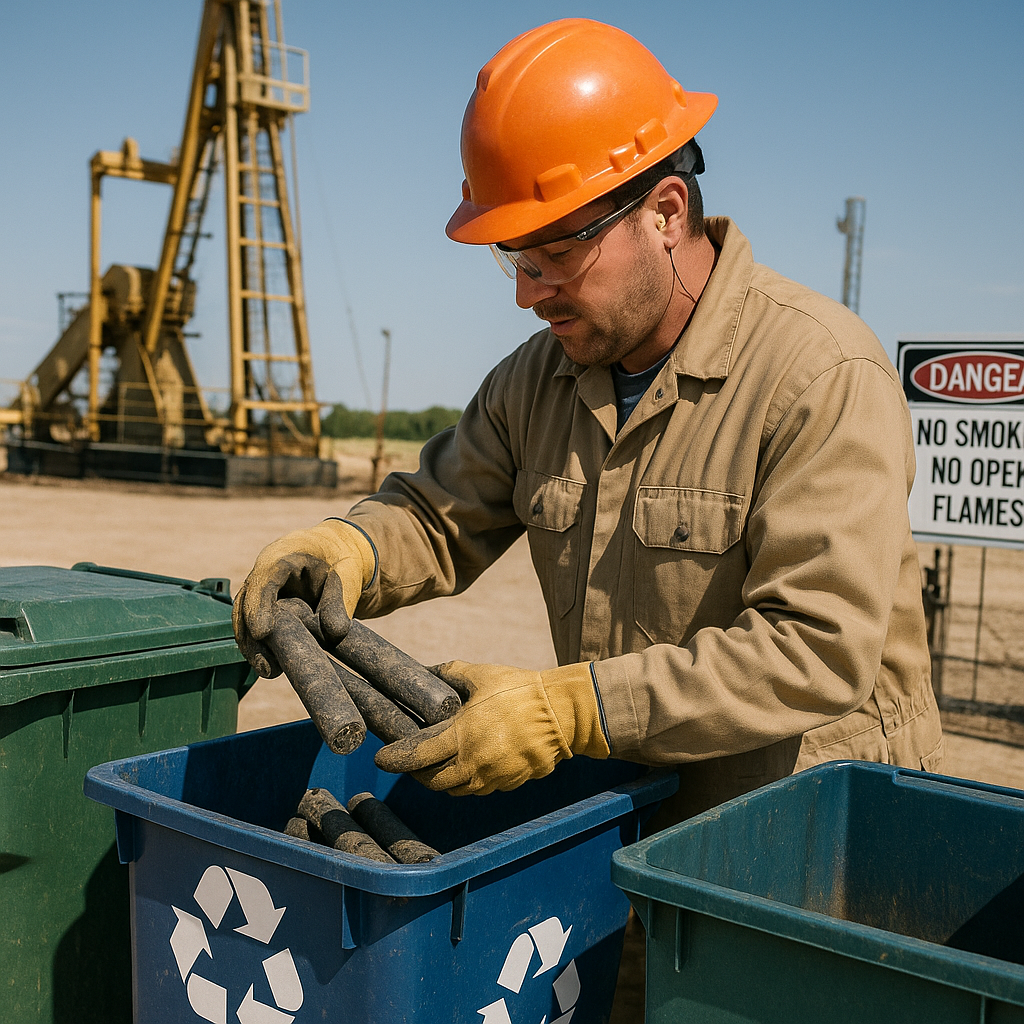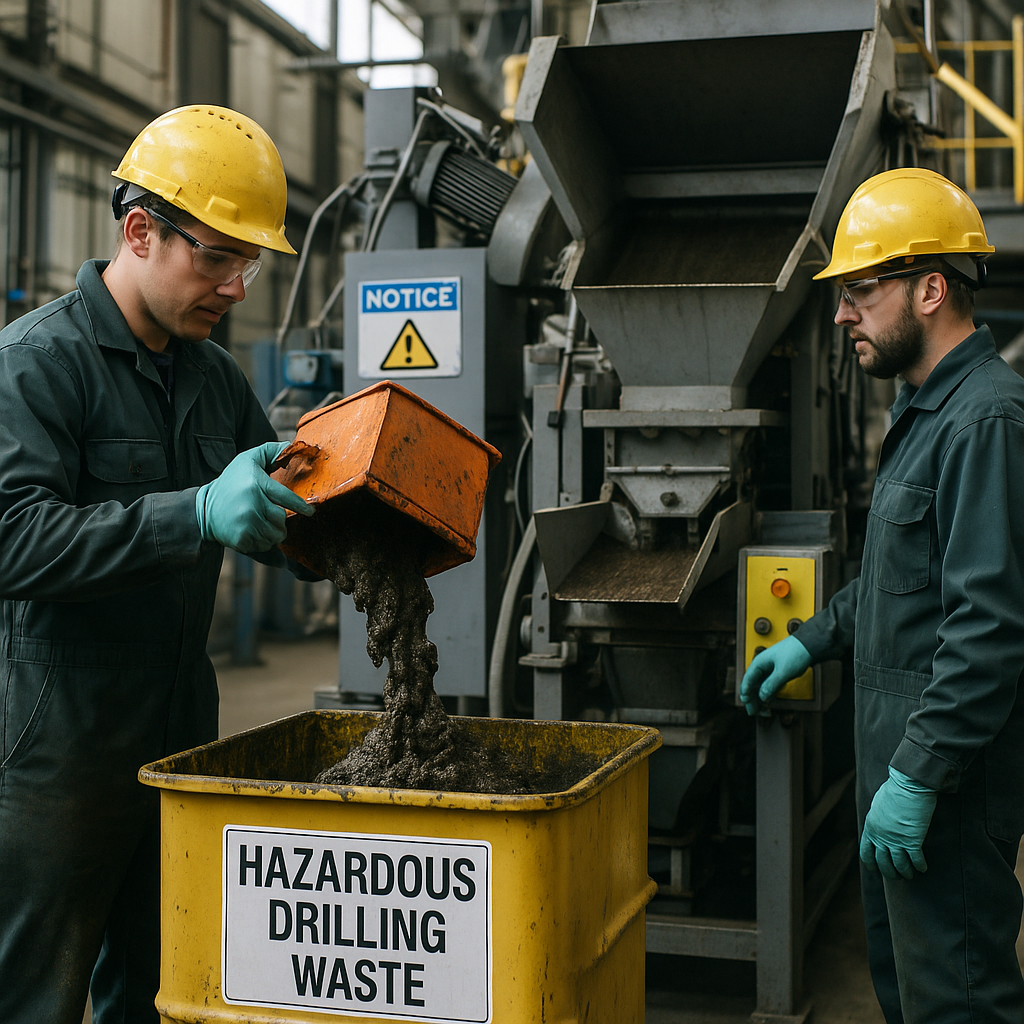5901 Botham Jean Blvd, Dallas, TX 75215
Recycling Hazardous Materials from Drilling Sites: A Quick
August 7, 2025Every day, oil and gas drilling operations across the country produce thousands of tons of potentially hazardous waste materials. These drilling byproducts contain a complex mixture of chemicals that can harm both human health and the environment if not handled properly.
Oil-contaminated drill cuttings (OCDC) are one of the most common hazardous materials from drilling sites. These rock fragments are ground up during the drilling process and become saturated with oil, drilling fluids, and other chemicals. When improperly disposed of, these cuttings can contaminate soil and groundwater with petroleum compounds that linger in the environment for years.
Understanding both the composition and potential dangers of drilling waste is the first critical step in developing effective management strategies. With proper identification, handling, and treatment, these hazardous materials can be safely managed to minimize their environmental and health impacts.
What Are the Benefits of Recycling Hazardous Drilling Materials?

The recycling of hazardous drilling materials offers significant benefits for both the environment and operational efficiency. These benefits extend beyond mere waste reduction, impacting multiple aspects of drilling operations.
Environmental Benefits of Recycling Drilling Waste
The environmental benefits of recycling hazardous drilling materials are both immediate and enduring. Proper recycling significantly conserves natural resources that would otherwise be depleted through extraction.
Resource conservation is a direct advantage. The EPA highlights that recycling hazardous waste achieves two key objectives: reducing raw material consumption and decreasing the volume of waste needing treatment, creating a cascade of positive environmental outcomes.
Pollution reduction occurs at various stages when drilling materials are recycled. The process significantly reduces air, water, and soil pollution usually linked to raw material extraction and processing, helping to protect local ecosystems from contamination.
Greenhouse gas emissions decrease significantly when hazardous drilling materials are recycled. The EPA reports that recycling cuts down energy needs for the extraction, transportation, and processing of raw materials. Reduced energy demand leads to lower fossil fuel usage, which in turn results in fewer carbon dioxide emissions.
Water conservation becomes a notable benefit when recycling programs are implemented in drilling operations. Dewatering methods allow operations to reclaim water from waste drilling fluids through mechanical or chemical separation. This reclaimed water can then be reused, reducing reliance on freshwater sources.
Economic Advantages for Drilling Operations
The financial incentives for recycling hazardous drilling materials are compelling. Companies that adopt effective recycling programs often experience several economic benefits that enhance operational success.
Waste management costs decrease significantly when recycling becomes standard practice. The Railroad Commission of Texas notes that recycling can slash operating expenses related to the disposal and treatment of hazardous materials. These savings accumulate quickly for operations generating large volumes of waste.
Regulatory compliance is simplified through recycling programs. By recycling hazardous materials, some waste streams may be entirely eliminated, potentially bypassing complex regulatory requirements, thereby reducing administrative overhead and potential liabilities.
Production efficiency improves with the integration of recycling into operations. Companies can boost their operational efficiency by reclaiming valuable components from waste streams. The EPA notes that recycling hazardous waste can enhance production systems while reducing costs for new raw materials.
Revenue opportunities arise when recycling programs recover valuable materials from waste streams. In some instances, recycled drilling materials can be sold or reused, creating new income sources. For example, treated drilling mud can be reconditioned and sold for use in other drilling operations.
Public relations benefits also present an economic advantage. Companies showing environmental responsibility through recycling programs often enjoy an enhanced public image and stronger stakeholder relationships. This positive perception can translate into tangible business benefits, including improved community relations and increased stakeholder support.
| Benefit Type | Details |
|---|---|
| Resource Conservation | Recycling reduces the need to extract raw materials, conserving natural resources. |
| Pollution Reduction | Reduces air, water, and soil pollution associated with raw material extraction and processing. |
| Greenhouse Gas Reduction | Lower energy needs for raw material processing cut fossil fuel use and emissions. |
| Water Conservation | Reclaimed water from dewatering can be reused, reducing demand on freshwater sources. |
| Cost Savings | Recycling reduces waste management costs and may eliminate some regulatory burdens. |
| Production Efficiency | Reclaiming valuable components enhances efficiency and reduces costs for new materials. |
| Revenue Opportunities | Valuable materials can be sold or reused, creating income sources. |
| Public Relations | Environmental responsibility can improve company image and stakeholder support. |
Practical Examples of Successful Recycling
Real-world applications show how recycling hazardous drilling materials can offer tangible benefits. Several practical approaches have been proven successful in the field.
Drilling fluid recycling is one of the most impactful opportunities. Instead of disposing of waste drilling fluids, companies can recondition them for reuse in future drilling projects. One company designed a multi-well project using the same drilling fluid for each successive well, achieving significant cost savings and reduced waste management issues.
Dewatering waste drilling fluids presents another effective approach. Large bowl centrifuges, hydrocyclones, and chemical flocculants can separate water from waste drilling fluids. The reclaimed water can then be reused as rigwash or makeup water for drilling fluid systems, reducing freshwater demand.
Closed-loop drilling systems showcase the integration of recycling principles into operational design. These systems use steel tanks instead of earthen pits to contain drilling fluids and include cuttings removal equipment. This setup enhances monitoring and makes recycling more efficient by keeping materials contained and accessible.
Treatment technologies have advanced significantly, making recycling more practical. Thermal desorption and bioremediation can effectively reduce the toxicity of drilling mud, allowing for safe reuse. These technologies transform what was once considered waste into valuable resources.
Long-Term Benefits for Industry Sustainability
In addition to immediate environmental and economic gains, recycling hazardous drilling materials supports the long-term sustainability of the drilling industry. These benefits better position companies for future success in an increasingly environmentally conscious business environment.
Reduced liability concerns are a significant long-term advantage. Companies that recycle hazardous drilling materials properly minimize potential future cleanup costs and legal issues associated with improper waste disposal. This risk reduction offers peace of mind and financial security.
Resource security is improved when operations reduce their dependence on new raw materials through recycling. This approach helps buffer companies against supply chain disruptions and price fluctuations in raw material markets, creating more stable operational conditions.
Adaptability to regulatory changes is made easier for companies with established recycling programs. As environmental regulations typically become more stringent over time, operations that already minimize waste generation through recycling will face fewer challenges when new requirements emerge.
How Are Hazardous Drilling Materials Recycled?

Hazardous drilling materials present significant environmental challenges. Fortunately, the recycling industry has developed effective methods to process these materials safely. These techniques both reduce environmental impact and help recover valuable resources from what would otherwise be waste.
Thermal Desorption
Thermal desorption is a physical separation process using heat to remove contaminants from drilling waste. It involves heating the material to temperatures between 200-600°C, causing petroleum hydrocarbons to vaporize and separate from the solids. These vapors are collected and either condensed for reuse or further treated.
The clean soil or drill cuttings remaining after treatment can often be repurposed for construction or land applications. This method is particularly effective for oil-based drilling muds, where valuable base oils can be recovered and reused in new operations.
Bioremediation
Bioremediation leverages natural biological processes to break down harmful substances in drilling waste. Microorganisms degrade petroleum hydrocarbons and other organic contaminants into harmless byproducts like water and carbon dioxide.
The industry employs several bioremediation techniques. Land farming spreads waste over soil, allowing microbes to break down contaminants. Bioreactors maintain optimal conditions for microbial activity in controlled environments. Though slower than thermal methods, bioremediation often requires less energy and is usually more cost-effective.
Chemical Treatment
Chemical treatment processes involve adding specific chemicals to drilling waste to neutralize contaminants or alter their physical properties. Common treatments include oxidation, reduction, neutralization, and stabilization.
For example, chemical flocculation uses substances that cause suspended particles to clump together, simplifying their removal from waste drilling fluids. This not only treats the waste but can reclaim water for reuse. Chemical encapsulation binds contaminants within a solid matrix, preventing environmental leaching.
Advanced Recycling Technologies
Several advanced technologies are transforming the handling of hazardous drilling waste:
Ultrasonic treatment uses sound waves to break down contaminants and separate components of drilling waste. High-frequency vibrations create intense pressure and temperature conditions that degrade complex petroleum compounds and improve separation efficiency.
Pyrolysis processes waste materials at high temperatures (400-800°C) without oxygen, converting organic materials into biochar, synthetic gas, and bio-oils for use as energy sources or chemical feedstocks.
Closed-Loop Systems
Perhaps the most effective approach to hazardous drilling waste is minimizing its generation. Closed-loop drilling systems make significant advances in this area. Unlike traditional systems with open reserve pits, closed-loop systems contain drilling fluids in a series of tanks and mechanical equipment.
Specialized solids control equipment, including shale shakers, hydrocyclones, and centrifuges, continuously cleans and recirculates drilling fluids. These systems maintain fluid quality, reduce waste volume, and minimize the need for fresh materials.
Water Reclamation
Water comprises a significant portion of drilling fluids, representing a valuable resource, especially in water-scarce regions. Several techniques can reclaim water from waste drilling fluids:
Centrifugation separates solids from liquids using centrifugal force. Large bowl centrifuges spin at high speeds, pushing heavier particles outward while cleaner water collects toward the center.
Chemical treatments aid in water recovery. Flocculants and coagulants help separate suspended particles from water, producing clearer water for reuse or safe discharge after meeting regulatory criteria.
Selecting the Right Recycling Method
The best recycling method for hazardous drilling materials depends on multiple factors:
Waste composition is crucial—different contaminants require different treatment approaches. The concentration of petroleum hydrocarbons, heavy metals, and other compounds will influence method effectiveness.
Regulatory requirements also play a significant role. Different jurisdictions have specific rules about processing drilling waste before disposal or reuse.
Cost considerations include not just the immediate expense of treatment, but also transportation, energy consumption, and potential value of recovered materials. Some methods may cost more initially but provide better long-term environmental and economic outcomes.
| Method | Description | Benefits | Challenges |
|---|---|---|---|
| Thermal Desorption | Heats waste to 200-600°C to vaporize and separate petroleum hydrocarbons. | Recovers clean soil and valuable base oils; effective for oil-based muds. | Energy intensive; requires equipment for vapor collection. |
| Bioremediation | Uses microorganisms to degrade petroleum hydrocarbons into harmless byproducts. | Less energy required; cost-effective. | Longer treatment time; may need controlled conditions. |
| Chemical Treatment | Neutralizes contaminants through chemical reactions like oxidation and stabilization. | Can reclaim water for reuse; effective for specific contaminants. | May require specific chemical treatments for different waste types. |
| Advanced Recycling Technologies | Includes ultrasonic treatment and pyrolysis for waste decomposition and recovery. | Improves separation efficiency; generates valuable byproducts. | High technical and equipment costs. |
| Closed-Loop Systems | Contains drilling fluids in tanks, reducing waste generated. | Reduces fresh material use and waste volume. | Implementation complexity; initial setup costs. |
| Water Reclamation | Uses centrifugation and chemical treatments to separate and reclaim water. | Conserves water; reduces need for fresh sources. | Changes water chemical composition; cost dependent on equipment. |
As the oil and gas industry focuses more on sustainability, recycling technologies for hazardous drilling materials will continue to advance. These innovations not only protect the environment but also improve resource efficiency and can reduce operational costs for drilling companies.
What Regulations Govern Hazardous Waste Recycling in Drilling Operations?

Hazardous waste recycling in drilling operations is strictly regulated through a complex framework of federal and state laws. The Resource Conservation and Recovery Act (RCRA) is the primary federal legislation governing these activities. Understanding these regulations is crucial for drilling operators to manage compliance effectively while handling their waste streams.
The Role of RCRA in Hazardous Waste Management
RCRA Subtitle C establishes the foundation for managing hazardous waste across the United States. This comprehensive legislation authorizes the Environmental Protection Agency (EPA) to regulate hazardous waste throughout its lifecycle—from generation to disposal. The framework includes specific requirements for tracking waste from creation to final disposition and mandates permitting for hazardous waste management facilities.
For drilling operations, RCRA distinguishes between exempt and non-exempt wastes. In 1988, the EPA determined that certain exploration and production (E&P) wastes would be exempt from Subtitle C hazardous waste regulations. These exemptions apply to wastes uniquely associated with drilling, such as produced water, drilling fluids, and drill cuttings.
However, not all drilling wastes qualify for this exemption. Materials like unused fracturing fluids, spent solvents, and waste lubricating oils remain fully subject to RCRA Subtitle C when they exhibit hazardous characteristics.
EPA’s Regulatory Framework
The EPA implements RCRA through specific regulations codified in Title 40 of the Code of Federal Regulations (CFR), parts 260 through 273. These regulations establish:
- Criteria for identifying and listing hazardous wastes
- Standards for hazardous waste generators
- Requirements for transporters
- Operating standards for treatment, storage, and disposal facilities
- Land disposal restrictions
- Permitting requirements
For non-exempt hazardous wastes in drilling operations, these regulations impose strict management practices. Generators must accurately characterize their waste, maintain proper documentation, and ensure appropriate handling throughout the lifecycle.
State-Level Regulations
While federal regulations provide the baseline, individual states often implement more stringent requirements. The EPA encourages states to assume primary responsibility for hazardous waste programs through a process called state authorization. Currently, most states have received authorization to implement their own hazardous waste programs instead of the federal program.
State regulations may include additional requirements for:
- Waste characterization and testing procedures
- Storage facility design and operation
- Transportation manifests and reporting
- Treatment technologies and disposal methods
- Recycling and recovery options
Drilling operators must carefully review regulations in each state where they operate, as requirements can vary significantly. Some states have developed specific legislation and updated regulations to address increased hydraulic fracturing activities, including waste management regulations.
Key Compliance Requirements
Drilling operations handling hazardous waste must comply with several key requirements:
First, operators must determine whether their waste streams qualify as hazardous under RCRA or state definitions. This waste determination process requires careful analysis of waste composition and characteristics.
Second, for non-exempt hazardous wastes, operators must follow generator requirements based on the volume of waste produced monthly. These classifications—Very Small Quantity Generator, Small Quantity Generator, or Large Quantity Generator—determine the specific applicable regulations.
Third, proper containment, storage, and labeling of hazardous waste are mandatory. Regulations specify design standards for storage areas, maximum storage times, and inspection requirements.
Fourth, transporters of hazardous waste must comply with Department of Transportation regulations and use the Uniform Hazardous Waste Manifest system to track waste shipments.
Finally, treatment and disposal must occur at permitted facilities, with documentation maintained throughout the process. Land disposal restrictions may require specific treatment before disposal.
Enforcement and Penalties
The EPA and state environmental agencies actively enforce hazardous waste regulations through inspections, reporting requirements, and enforcement actions. Violations can result in significant penalties, including substantial fines and potential criminal charges for willful or knowing violations.
Recent enforcement trends show increased scrutiny of the oil and gas industry, particularly regarding waste characterization, storage practices, and documentation. Companies that implement robust compliance programs and maintain thorough records fare better during regulatory inspections.
For drilling operators, developing a comprehensive hazardous waste management plan is essential. This plan should address waste identification, handling procedures, staff training, emergency response, and documentation requirements. Regular audits and compliance checks help maintain adherence to evolving regulatory standards.
Understanding and complying with these complex regulations not only protect companies from penalties but also demonstrate environmental responsibility and commitment to sustainable operations.
Conclusion: Prioritizing Safe and Sustainable Recycling in Drilling Operations
Effectively managing hazardous drilling materials is essential for protecting both our environment and public health, while also maintaining the efficiency and profitability of oil and gas operations. As this article demonstrates, recycling hazardous drilling waste offers a range of benefits—from conserving natural resources and reducing pollution to lowering costs and enhancing regulatory compliance. With a variety of proven recycling methods—such as thermal desorption, bioremediation, and closed-loop systems—drilling operators now have more options than ever to recover valuable resources, reclaim water, and reduce their environmental impact.
Staying up to date with federal and state regulations is critical, as compliance not only avoids penalties but also builds public trust and strengthens a company’s reputation for environmental responsibility. As new recycling technologies continue to emerge and sustainability becomes increasingly important, forward-thinking operators will find that investing in robust waste management and recycling programs supports both immediate and long-term success.
To learn more about safe, compliant, and cost-effective recycling solutions for hazardous drilling materials, call Okon Recycling at 214-717-4083 today.
